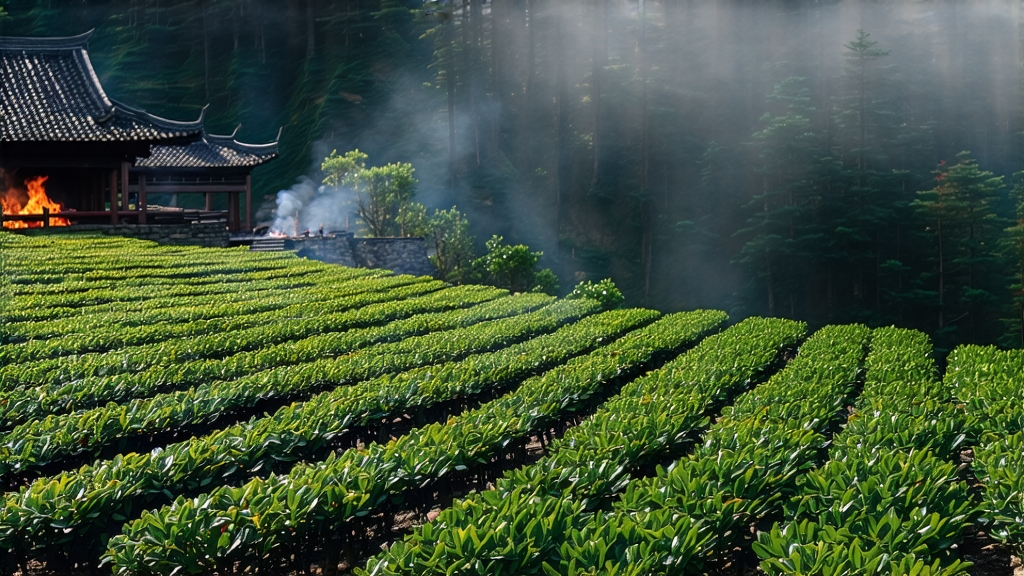
When European tea drinkers first encountered the dark, twisted leaves that produced a liquor the color of claret and a scent reminiscent of a campfire, they could not have imagined they were tasting the primordial form of what would become the world’s most popular beverage category: black tea. That leaf was Lapsang Souchong, a tea whose very name—"small sort from the pine grove"—hints at the landscape and the craft that created it. Grown in the granite gorges of the Wuyi massif in northern Fujian, Lapsang Souchong is both a historical document and a living flavor, a tea that carries within its aroma the memory of 17th-century trade caravans, Qing-dynasty potters, and the first global commodity boom.
Historical backdrop
The Wuyi Mountains have been a tea-producing region since the Song dynasty, but the innovation that defines Lapsang Souchong is usually dated to the late Ming, around 1600. Local lore speaks of an army unit passing through Tongmu village during harvest season; to dry the leaves quickly before they spoiled, farmers spread them over pine fires. The resulting smoky leaf, initially considered a mistake, found eager buyers among the Dutch traders anchored at Xiamen. By the time the English East India Company began regular purchases in the 1660s, “bohea” (a corruption of “Wuyi”) had become synonymous in Europe with the dark, fully oxidized tea we now call black. Lapsang Souchong was therefore not merely one commodity among many—it was the prototype that taught the world what black tea could be.
Micro-terroir and cultivars
Authentic Lapsang Souchong comes from a 600-meter-high pocket of subtropical forest inside the Wuyi National Nature Reserve, where cool nights, frequent fog, and mineral-rich, sandy-loam soil force the tea bush to grow slowly, concentrating amino acids and volatile aromatics. The traditional cultivar is Xiao Ye Zhong (“small-leaf species”), a shrub whose narrow, tender leaves contain a higher ratio of monoterpene alcohols—the very compounds that bond to pine smoke. In recent decades, farmers outside the reserve have planted larger-leaf Fuding Da Bai or Wuniuzao to meet export demand, but connoisseurs insist that only the original micro-terroir can yield the sweet, resinous balance that made the tea legendary.
Plucking standard
The classic pick is the “two and a half leaf” standard: the unopened bud, the first fully opened leaf, and the second leaf half the size of the first. This ratio maximizes the concentration of catechins while retaining enough stem to conduct smoke evenly during firing. Picking occurs only on windless mornings between Grain Rain and the beginning of summer, when the leaf’s moisture content hovers around 75 %—pliable enough to withstand rolling yet dry enough to absorb smoke later.
Crafting the smoke: a four-act play
- Withering: baskets of fresh leaf are laid on bamboo racks above rooms warmed by gentle pine embers. Over six to eight hours the leaf loses roughly 60 % of its moisture, turning from bright jade to a muted olive.
- Rolling: once the leaf feels leathery, it is rolled in tight spirals on rattan trays, rupturing cell walls and initiating oxidation. The juice exuded is already fragrant with maltol, the same compound that gives toasted bread its sweetness.
- Oxidation: the rolled leaf is piled in cedar-lined crates and left in a humid loft for three to five hours. Enzymes convert catechins into theaflavins and thearubigins, turning the leaf coppery and developing the base notes of dried longan and dark honey.
- Smoking & firing: the decisive step. Pinewood from nearby Masson pines is burned until it glows; the flames are then smothered to produce a steady stream of cool, aromatic smoke. The oxidized leaf is passed on sieves through this smoke in four short bursts, each followed by a rest period. The goal is not to cook the leaf but to let the smoke’s phenols—guaiacol, syringol, creosol—condense on the still-moist surface. Finally, the leaf is given a high-temperature bake (100 °C) for two minutes to fix the aroma and reduce moisture to 4 %.
Grades and style variations
Within Tongmu, three grades are recognized:
- Zheng Shan